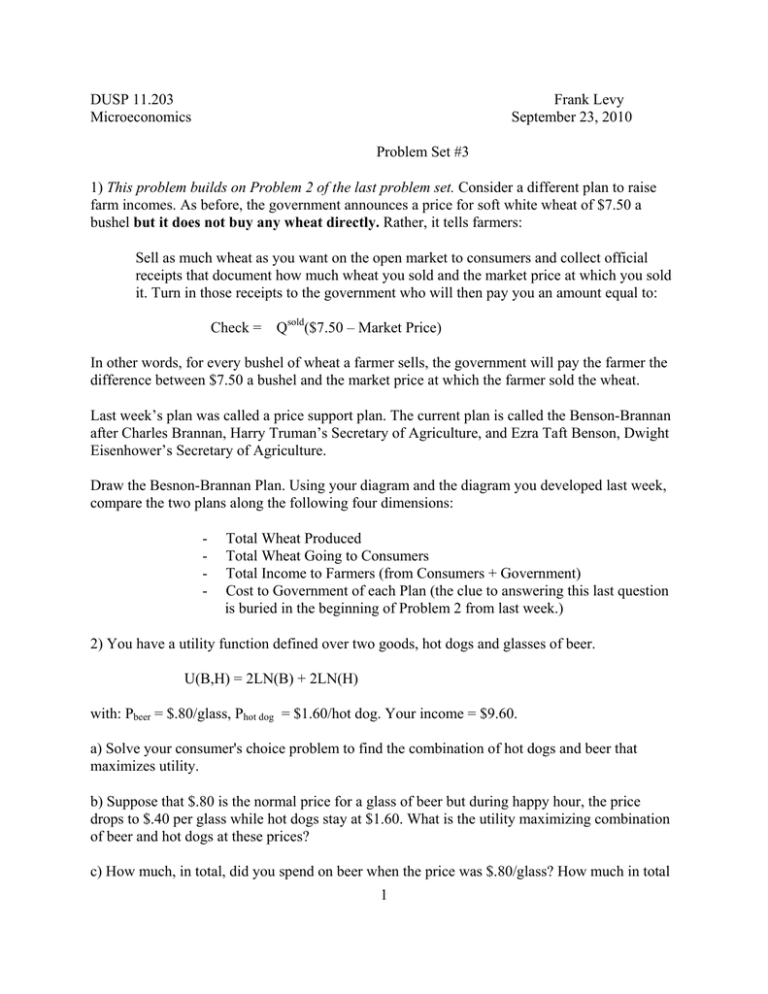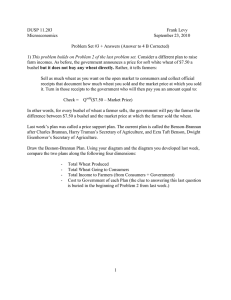DUSP 11.203 Frank Levy Microeconomics
advertisement

DUSP 11.203 Microeconomics Frank Levy September 23, 2010 Problem Set #3 1) This problem builds on Problem 2 of the last problem set. Consider a different plan to raise farm incomes. As before, the government announces a price for soft white wheat of $7.50 a bushel but it does not buy any wheat directly. Rather, it tells farmers: Sell as much wheat as you want on the open market to consumers and collect official receipts that document how much wheat you sold and the market price at which you sold it. Turn in those receipts to the government who will then pay you an amount equal to: Check = Qsold($7.50 – Market Price) In other words, for every bushel of wheat a farmer sells, the government will pay the farmer the difference between $7.50 a bushel and the market price at which the farmer sold the wheat. Last week’s plan was called a price support plan. The current plan is called the Benson-Brannan after Charles Brannan, Harry Truman’s Secretary of Agriculture, and Ezra Taft Benson, Dwight Eisenhower’s Secretary of Agriculture. Draw the Besnon-Brannan Plan. Using your diagram and the diagram you developed last week, compare the two plans along the following four dimensions: - Total Wheat Produced Total Wheat Going to Consumers Total Income to Farmers (from Consumers + Government) Cost to Government of each Plan (the clue to answering this last question is buried in the beginning of Problem 2 from last week.) 2) You have a utility function defined over two goods, hot dogs and glasses of beer. U(B,H) = 2LN(B) + 2LN(H) with: Pbeer = $.80/glass, Phot dog = $1.60/hot dog. Your income = $9.60. a) Solve your consumer's choice problem to find the combination of hot dogs and beer that maximizes utility. b) Suppose that $.80 is the normal price for a glass of beer but during happy hour, the price drops to $.40 per glass while hot dogs stay at $1.60. What is the utility maximizing combination of beer and hot dogs at these prices? c) How much, in total, did you spend on beer when the price was $.80/glass? How much in total 1 did you spend on beer when the price was $.40 per glass? What does this comparison tell you about the elasticity of demand for beer that comes from this utility function? d) Suppose the Massachusetts State Legislature, appalled at the extent of drunk driving, requires all restaurants and bars to institute a safe-drinking program that bans happy hour prices and limits each customer to three beers. What would your utility maximizing solution be in this case? (Don’t jump to the mathematics but rather reason this one through). 3) Consider the following diagram: 25 20 Cans of Peaches 15 10 5 0 5 10 15 20 25 30 35 Cans of Pears Price of a Can of Peaches = $2.00, Income = $30.00 a) Fill in several more indifference curves. Then draw a budget constraint assuming the Price of 2 a Can of Pears = $2.00. b) Using the indifference curves you have drawn, plot one point on a demand curve for cans of pears. c) Draw several other budget lines corresponding to the price of a can of pears varying between $6.00 per can and $1.00 per can. For each budget line, read off the number of cans of pears in your utility maximizing solution and use that information to start filling in other points on your demand curve. d) As part of your homework, include either the original or a Xerox of your indifference curve map (above) and the demand curve you created. 4) a) In Problem (3) above, as the price of a can of pears fell from $6.00 to $1.00, describe what happened to the number of cans of Peaches you bought. How do you explain this? b) The demand elasticity we have studied in class is formally called the “own-price elasticity” – i.e. the sensitivity of a product’s demand to its own price. We can also define a “cross-price elasticity” which is the percentage change in demand of one good caused by a 1 percent change in the price of a different good. Suppose we consider the budget of a typical suburban family and focus on two cross-elasticities of demand (for simplicity, I write peaches instead of cans of peaches, etc): ε peaches, pears = (ΔQpeaches/Qpeaches)/( ΔPpears/Ppears) ε peaches, gasoline = (ΔQ peaches/Qpeaches)/(ΔPgallon of gasoline/Pgallon of gasoline) Discuss what sign each elasticity will likely have. Disregarding signs for a moment, explain which elasticity you expect to be larger in magnitude and why? 5) (The Shoup reading may be helpful here). Analysts in the Burlington VT. Police Department allocate police patrols among three districts, each containing about 41,000 residents. They have applied statistical analysis to historical crime data to estimate the relationship between the number of patrols in a district and its crime rate. Since the demographics of the three districts are quite different (the student district is the worst), the patrol-crime rate function varies by district as well. Specifically: District 1: Crime Rate/1000 residents = 42 - 3P.73 District 2: Crime Rate/1000 residents = 67 - 5P.58 3 District 3: Crime Rate/1000 residents = 30 - 4P.87 Where: P is the number of patrols per day. a) Choose ONE of these three functions and take its first derivative to demonstrate that: - Adding more patrols in the district always reduces the crime rate - Each additional patrol reduces crime by less than the previous patrol b) The department staffs 60 patrols per day. The analysts have chosen to allocate 20 patrols to each district in the name of equality. If the analysts wanted to reduce the city’s crime rate as much as possible, is this the allocation they would choose? Explain why or why not (You don’t have to calculate a new allocation even if one is needed.). c) Dividing the 60 patrols equally among the districts is one definition of equality but there are others. Describe one or two other definitions of equality that the analysts might have pursued. **************************************** 4 MIT OpenCourseWare http://ocw.mit.edu 11.203 Microeconomics Fall 2010 For information about citing these materials or our Terms of Use, visit: http://ocw.mit.edu/terms.



